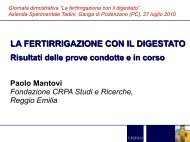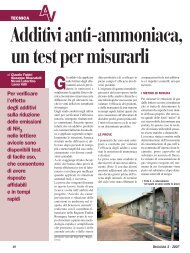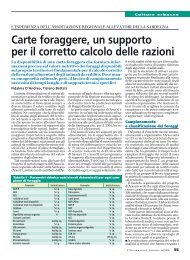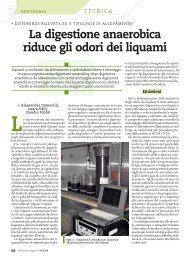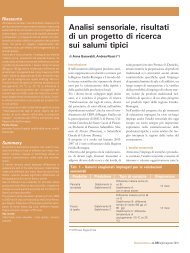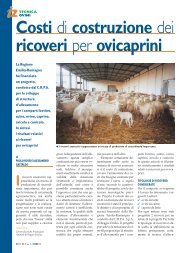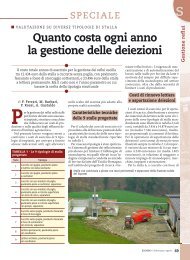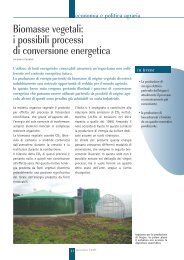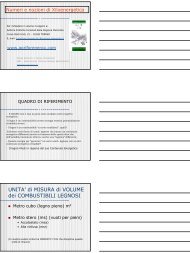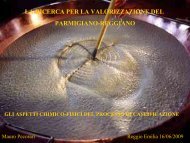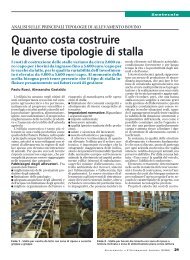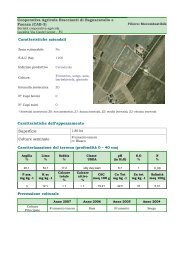Quale futuro per i produttori di latte in Italia? - Centro Ricerche ...
Quale futuro per i produttori di latte in Italia? - Centro Ricerche ...
Quale futuro per i produttori di latte in Italia? - Centro Ricerche ...
Create successful ePaper yourself
Turn your PDF publications into a flip-book with our unique Google optimized e-Paper software.
18<br />
IL PROGETTO INNOVALATTE 2030<br />
2. assicurare un tenore <strong>di</strong> vita equo alla popolazione agricola, grazie<br />
<strong>in</strong> particolare al miglioramento del red<strong>di</strong>to <strong>in</strong><strong>di</strong>viduale <strong>di</strong> coloro che<br />
lavorano nell’agricoltura;<br />
3. stabilizzare i mercati;<br />
4. garantire la sicurezza degli approvvigionamenti;<br />
5. assicurare prezzi ragionevoli nella <strong>di</strong>stribuzione ai consumatori.<br />
Mentre alcuni <strong>di</strong> questi obiettivi, strettamente correlati tra loro, sono<br />
stati raggiunti nel volgere <strong>di</strong> pochi anni, altri non sono stati raggiunti con<br />
lo stesso successo, anche <strong>per</strong>ché mettevano <strong>in</strong> relazione f<strong>in</strong>alità <strong>in</strong> antitesi<br />
tra <strong>di</strong> loro, come, <strong>per</strong> esempio, il miglioramento del red<strong>di</strong>to degli agricoltori<br />
e i prezzi ragionevoli ai consumatori. Il tentativo <strong>di</strong> raggiungere questi<br />
obiettivi facendoli convivere tra <strong>di</strong> loro ha rappresentato un lungo lavoro<br />
<strong>di</strong> cont<strong>in</strong>ua revisione della PAC, anche alla luce degli stravolgimenti politici<br />
ed economici avvenuti negli ultimi decenni. Basti pensare alla caduta<br />
del muro <strong>di</strong> Berl<strong>in</strong>o e qu<strong>in</strong><strong>di</strong> alla f<strong>in</strong>e della guerra fredda e all’allargamento<br />
della Unione europea a 27 Paesi, decisamente impensabile all’epoca del<br />
trattato <strong>di</strong> Roma. Un altro elemento non trascurabile è stato la nascita<br />
dell’euro, che ha legato <strong>in</strong><strong>di</strong>ssolubilmente le economie agricole <strong>di</strong> alcuni<br />
Paesi chiave europei, <strong>in</strong> particolare i fondatori della Unione europea, tra<br />
cui Francia, Germania e <strong>Italia</strong>.<br />
Facendo <strong>per</strong>ò un passo <strong>in</strong><strong>di</strong>etro, già a pochi anni dalla sua applicazione<br />
la PAC <strong>in</strong>izia a mostrare i propri limiti, <strong>in</strong> particolare a causa <strong>di</strong> un <strong>in</strong>cremento<br />
delle produzioni tale da non poter essere assorbito dal consumo<br />
<strong>in</strong>terno. In l<strong>in</strong>ea <strong>di</strong> pr<strong>in</strong>cipio era un elemento positivo che <strong>per</strong>metteva <strong>di</strong><br />
raggiungere gli obiettivi 1, 4 e <strong>in</strong> parte 5, creando problemi <strong>per</strong>ò al raggiungimento<br />
dei punti 2 e 3.<br />
Le misure che vengono adottate <strong>per</strong> gestire le eccedenze produttive<br />
(sussi<strong>di</strong> alle esportazioni, stoccaggi, <strong>di</strong>struzione <strong>di</strong> prodotto, ecc.) <strong>di</strong>ventano<br />
presto poco gra<strong>di</strong>te dall’op<strong>in</strong>ione pubblica e <strong>di</strong>ventano rapidamente<br />
<strong>in</strong>accettabili <strong>in</strong> term<strong>in</strong>i <strong>di</strong> spesa pubblica. Per ovviare a questa situazione,<br />
<strong>in</strong> particolare negli anni 80’, si <strong>in</strong>troducono i primi meccanismi <strong>di</strong> limitazione<br />
delle produzioni che riguardano anche gli eccessi produttivi del<br />
settore lattiero-caseario che si manifestano <strong>in</strong> particolare con enormi stoccaggi<br />
<strong>di</strong> polvere <strong>di</strong> <strong>latte</strong> e burro.<br />
Nel 1984 venne creato il sistema delle quote <strong>latte</strong>, che ha attribuito<br />
limiti produttivi nazionali <strong>per</strong> ciascun Paese membro e limiti <strong>in</strong><strong>di</strong>viduali<br />
<strong>per</strong> le s<strong>in</strong>gole aziende da <strong>latte</strong>. Il pr<strong>in</strong>cipio delle quote prevede, come <strong>per</strong><br />
le altre produzioni, che la limitazione dell’offerta riduca le eccedenze e<br />
<strong>in</strong>contrando la domanda mantenga alto il prezzo <strong>di</strong> mercato, con conseguenti<br />
benefici <strong>per</strong> il bilancio pubblico e <strong>per</strong> l’economia delle aziende<br />
zootecniche. Il funzionamento del regime fa <strong>in</strong> modo che la produzione<br />
annuale <strong>di</strong> ogni allevatore non su<strong>per</strong>i il livello consentito e, ove ciò si verificasse,<br />
prevede la riscossione <strong>di</strong> sanzioni a carico dei <strong>produttori</strong> con<br />
eccedenze rispetto alla quota <strong>di</strong> riferimento <strong>in</strong><strong>di</strong>viduale.



